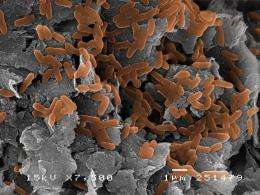May 3, 2010 weblog
Fuel-producing Geobacter receives support from new research grant

(PhysOrg.com) -- Last week, the US Department of Energy awarded $106 million to 37 projects to support the development of advanced energy technologies. One of the promising projects is Geobacter, named after a bacterial species that uses electric current to convert carbon dioxide into transportation fuels such as butanol. Led by microbiologist Derek Lovley and colleagues from the University of Massachusetts-Amherst, the project received an initial $1 million research grant to expand its research.
Geobacter has the potential to generate butanol at a cost of just $2 per gallon, according to a recent article in the New York Times. The technology is called microbial electrosynthesis, which represents a new form of photosynthesi. The researchers have genetically modified the Geobacter bacterium so that it acts like a reverse fuel cell, using electricity generated from solar panels to produce fuels and other useful products.
The researchers are currently growing the bacteria on the surface of graphite electrodes located on a rooftop. A rooftop solar panel captures energy and delivers it to the electrode in the form of electricity. Using its hair-like pili, the Geobacter feeds on the electrons, which cause it to “breathe in” carbon dioxide and “exhale” fuels. In addition to the fuel butanol, the process could also yield other chemicals such as butanediol, which is used to make plastics.
As the researchers explain, microbial electrosynthesis works at a much higher efficiency than traditional photosynthesis. This efficiency is partly due to the fact that solar panels can harvest solar energy 100 times more effectively than plants. Also, a year ago, the scientists developed a new Geobacter strain that is eight times more efficient than other strains at producing power. Another advantage of microbial electrosynthesis is that it can be used with existing infrastructure, and doesn’t require arable land or intensive farming of biofuel crops.
“Sunlight is the most abundant source of renewable energy,” explain the researchers on their website, Geobacter.org. “Photovoltaic technology for converting solar energy into electricity is well developed and can harvest solar energy much more effectively than photosynthesis. However, photovolatics only produce electricity when the sun is shining. Storing electricity is difficult. [Microbial electrosynthesis] technology can convert the electrical energy produced from solar panels into chemical energy in the form of fuels and chemicals. Fuels and chemicals are easily stored and can be distributed through existing infrastructure on an as needed basis.”
Generating fuel is just one useful application of Geobacter. When Lovley discovered the first Geobacter species in the Potomac River in 1987, he initially investigated how its ability to oxidize iron, radioactive materials, and petroleum compounds could be used to decontaminate soil. In addition, because this oxidation process produces electricity, Geobacter could be used as a microbial fuel cell, converting organic waste matter - including human and animal solid waste - into electricity.
Researchers are also sequencing the genomes of several Geobacter species and incorporating them into a computer model that can predict Geobacter metabolism under different environmental conditions, which will help scientists optimize their use in environmental restoration and energy harvesting applications.
More information:
Geobacter.org
via: New York Times
© 2010 PhysOrg.com



















